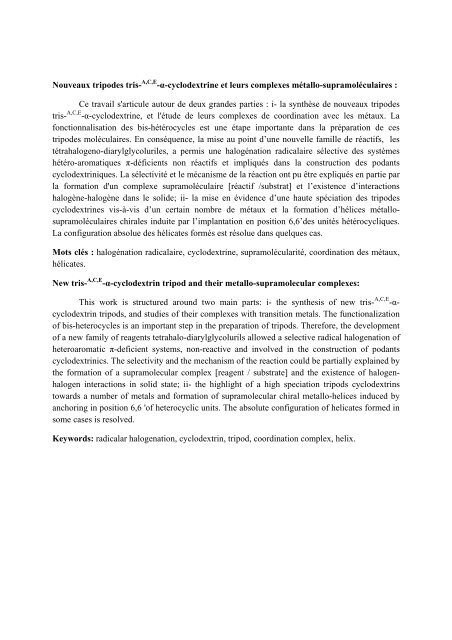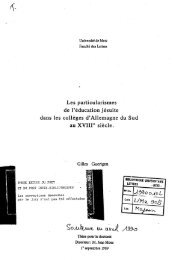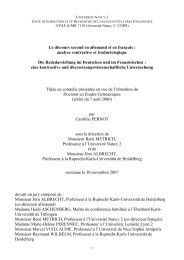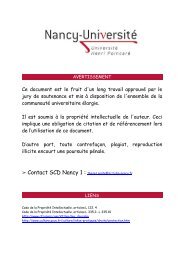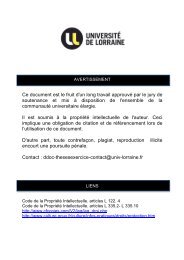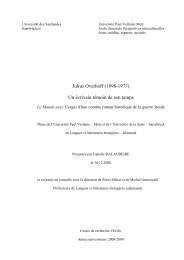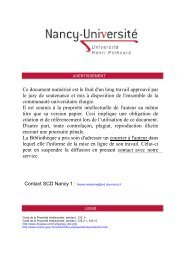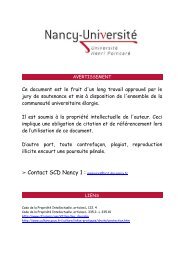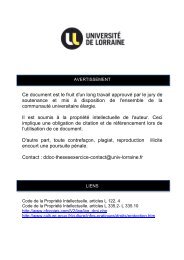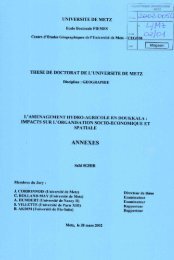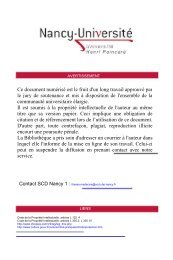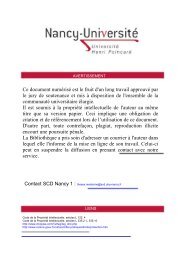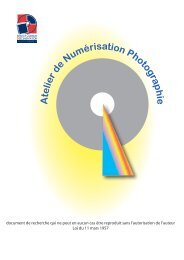Ce document est le fruit d'un long travail approuvé par le jury de ...
Ce document est le fruit d'un long travail approuvé par le jury de ...
Ce document est le fruit d'un long travail approuvé par le jury de ...
Create successful ePaper yourself
Turn your PDF publications into a flip-book with our unique Google optimized e-Paper software.
Nouveaux tripo<strong>de</strong>s tris- A,C,E -α-cyclo<strong>de</strong>xtrine et <strong>le</strong>urs comp<strong>le</strong>xes métallo-supramoléculaires :<br />
<strong>Ce</strong> <strong>travail</strong> s'articu<strong>le</strong> autour <strong>de</strong> <strong>de</strong>ux gran<strong>de</strong>s <strong>par</strong>ties : i- la synthèse <strong>de</strong> nouveaux tripo<strong>de</strong>s<br />
tris- A,C,E -α-cyclo<strong>de</strong>xtrine, et l'étu<strong>de</strong> <strong>de</strong> <strong>le</strong>urs comp<strong>le</strong>xes <strong>de</strong> coordination avec <strong>le</strong>s métaux. La<br />
fonctionnalisation <strong>de</strong>s bis-hétérocyc<strong>le</strong>s <strong>est</strong> une étape importante dans la pré<strong>par</strong>ation <strong>de</strong> ces<br />
tripo<strong>de</strong>s moléculaires. En conséquence, la mise au point d’une nouvel<strong>le</strong> famil<strong>le</strong> <strong>de</strong> réactifs, <strong>le</strong>s<br />
tétrahalogeno-diarylglycoluri<strong>le</strong>s, a permis une halogénation radicalaire sé<strong>le</strong>ctive <strong>de</strong>s systèmes<br />
hétéro-aromatiques π-déficients non réactifs et impliqués dans la construction <strong>de</strong>s podants<br />
cyclo<strong>de</strong>xtriniques. La sé<strong>le</strong>ctivité et <strong>le</strong> mécanisme <strong>de</strong> la réaction ont pu être expliqués en <strong>par</strong>tie <strong>par</strong><br />
la formation <strong>d'un</strong> comp<strong>le</strong>xe supramoléculaire [réactif /substrat] et l’existence d’interactions<br />
halogène-halogène dans <strong>le</strong> soli<strong>de</strong>; ii- la mise en évi<strong>de</strong>nce d’une haute spéciation <strong>de</strong>s tripo<strong>de</strong>s<br />
cyclo<strong>de</strong>xtrines vis-à-vis d’un certain nombre <strong>de</strong> métaux et la formation d’hélices métallosupramoléculaires<br />
chira<strong>le</strong>s induite <strong>par</strong> l’implantation en position 6,6’<strong>de</strong>s unités hétérocycliques.<br />
La configuration absolue <strong>de</strong>s hélicates formés <strong>est</strong> résolue dans quelques cas.<br />
Mots clés : halogénation radicalaire, cyclo<strong>de</strong>xtrine, supramolécularité, coordination <strong>de</strong>s métaux,<br />
hélicates.<br />
New tris- A,C,E -α-cyclo<strong>de</strong>xtrin tripod and their metallo-supramo<strong>le</strong>cular comp<strong>le</strong>xes:<br />
This work is structured around two main <strong>par</strong>ts: i- the synthesis of new tris- A,C,E -αcyclo<strong>de</strong>xtrin<br />
tripods, and studies of their comp<strong>le</strong>xes with transition metals. The functionalization<br />
of bis-heterocyc<strong>le</strong>s is an important step in the pre<strong>par</strong>ation of tripods. Therefore, the <strong>de</strong>velopment<br />
of a new family of reagents tetrahalo-diarylglycolurils allowed a se<strong>le</strong>ctive radical halogenation of<br />
heteroaromatic π-<strong>de</strong>ficient systems, non-reactive and involved in the construction of podants<br />
cyclo<strong>de</strong>xtrinics. The se<strong>le</strong>ctivity and the mechanism of the reaction could be <strong>par</strong>tially explained by<br />
the formation of a supramo<strong>le</strong>cular comp<strong>le</strong>x [reagent / substrate] and the existence of halogenhalogen<br />
interactions in solid state; ii- the highlight of a high speciation tripods cyclo<strong>de</strong>xtrins<br />
towards a number of metals and formation of supramo<strong>le</strong>cular chiral metallo-helices induced by<br />
anchoring in position 6,6 'of heterocyclic units. The absolute configuration of helicates formed in<br />
some cases is resolved.<br />
Keywords: radicalar halogenation, cyclo<strong>de</strong>xtrin, tripod, coordination comp<strong>le</strong>x, helix.


